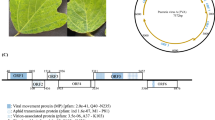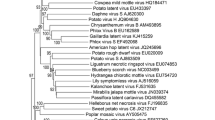Summary.
The complete nucleotide sequence of Pelargonium flower break virus (PFBV) has been determined. The genomic RNA is 3923 nucleotides (nt) long and contains five open reading frames (ORFs). The 5′-proximal ORF encodes a 27 kDa protein (p27) and terminates with an amber codon which may be read-through into an in-frame p56 ORF to generate a 86 kDa protein (p86) containing the viral RNA dependent-RNA polymerase motifs. Two small ORFs, located in the central part of the viral genome, encode polypeptides of 7 (p7) and 12 kDa (p12), respectively, which are very likely involved in virus movement. Interestingly, p12 presents a leucine zipper motif that has not been previously reported in related proteins. The 3′-proximal ORF encodes a 37 kDa capsid protein (CP). The p12 ORF is in-frame with the p86 ORF and a double read-through protein of 99 kDa (p99) may be produced. Amino acid sequence comparisons revealed that the proteins encoded by ORFs 2, 3 and 4 are more similar to the corresponding gene products of Carnation mottle virus than to those of other carmoviruses, whereas the p27 and the CP show higher identity with the equivalent proteins of Saguaro cactus virus. Phylogenetic analysis conducted with the different viral products confirmed the assignment of PFBV to the genus Carmovirus.
Similar content being viewed by others
Author information
Authors and Affiliations
Rights and permissions
About this article
Cite this article
Rico, P., Hernández, C. Complete nucleotide sequence and genome organization of Pelargonium flower break virus . Arch Virol 149, 641–651 (2004). https://doi.org/10.1007/s00705-003-0231-5
Received:
Accepted:
Published:
Issue Date:
DOI: https://doi.org/10.1007/s00705-003-0231-5




